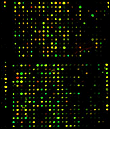Return to Online
Education Kit
|
 |
 |
 Previous Event | Next Event Previous Event | Next Event 
1991: ESTs, Fragments of Genes
 An expressed-sequence tag (EST) is a stretch of DNA sequence made by copying a portion of an mRNA molecule. As such, all ESTs replicate sequences from genes. They were first proposed as a useful way to find genes in the genome in 1991. A relatively small portion (approximately one-tenth) of the human genome is thought to be transcribed, or "expressed", and looking at ESTs is a way to home in on the expressed, clearly functional sequences in the genome that the nucleus sends out to the rest of the cell. An expressed-sequence tag (EST) is a stretch of DNA sequence made by copying a portion of an mRNA molecule. As such, all ESTs replicate sequences from genes. They were first proposed as a useful way to find genes in the genome in 1991. A relatively small portion (approximately one-tenth) of the human genome is thought to be transcribed, or "expressed", and looking at ESTs is a way to home in on the expressed, clearly functional sequences in the genome that the nucleus sends out to the rest of the cell.
More Information
Reference:
Adams, M.D., Kelley, J.M., Gocayne, J.D., Dubnick, M., Polymeropoulos, M.H., Xiao, H., Merril, C.R., et al. Complementary DNA sequencing: expressed sequence tags and human genome project. Science, 252:1651-6. 1991. [PubMed]
 Previous Event | Next Event Previous Event | Next Event 
Last Reviewed: April 17, 2008
|

